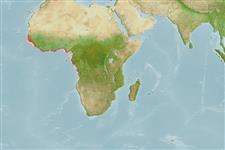Environment: milieu / climate zone / depth range / distribution range
Écologie
marin; eau douce; saumâtre démersal; catadrome (Ref. 51243); profondeur 0 - 25 m (Ref. 121789). Tropical; 21°N - 20°S, 18°W - 16°E
Length at first maturity / Taille / Poids / Âge
Maturity: Lm 17.8 range ? - ? cm
Max length : 41.0 cm FL mâle / non sexé; (Ref. 57400); common length : 27.0 cm SL mâle / non sexé; (Ref. 7399); poids max. publié: 262.00 g (Ref. 55664)
Épines anales: 3; Rayons mous anaux: 10 - 12. Diagnosis: anal fin with at least 13 (usually 14) rays in total (usually III-11 in adults)(Ref. 81659), 10-11 anal soft rays (Ref. 57400). Scales on flanks cycloid; posterior end of maxilla weakly curved or almost straight; serrate, anteroventral edge of lachrymal weakly concave (Ref. 81659). 12-15 scales in an oblique, transverse series; colour of fins greyish-white; second dorsal, pectoral fins and anal fin distinctly falcate (Ref. 57400).
Euryhaline, tolerating conditions varying from hypersaline to freshwater; favours sandy or muddy substrates (Ref. 81659). Very common in coastal lagoons and estuaries (Ref. 2683, 57400, 81659). Also caught in hypersaline environments (Ref. 57400) and freshwaters (Ref. 7399, 57400, 81659) several kilometres upstream in rivers (Ref. 81659). Feed on plankton and detritus (Ref. 28587). Oviparous, eggs are pelagic and non-adhesive (Ref. 205). Spawning may occur in lagoons or in the sea (Ref. 81659). Possibly reaches up to 500mm FL (Ref. 57400, 81659).
Life cycle and mating behavior
Maturité | Reproduction | Frai | Œufs | Fécondité | Larves
Thomson, J.M., 1990. Mugilidae. p. 855-859. In J.C. Quero, J.C. Hureau, C. Karrer, A. Post and L. Saldanha (eds.) Check-list of the fishes of the eastern tropical Atlantic (CLOFETA). JNICT, Lisbon; SEI, Paris; and UNESCO, Paris. Vol. 2. (Ref. 7399)
Statut dans la liste rouge de l'IUCN (Ref. 130435: Version 2024-1)
Menace pour l'homme
Harmless
Utilisations par l'homme
Pêcheries: commercial
Outils
Articles particuliers
Télécharger en XML
Sources Internet
Estimates based on models
Preferred temperature (Ref.
123201): 23.5 - 27.9, mean 26.5 °C (based on 62 cells).
Phylogenetic diversity index (Ref.
82804): PD
50 = 1.0000 [Uniqueness, from 0.5 = low to 2.0 = high].
Bayesian length-weight: a=0.01096 (0.00964 - 0.01248), b=2.95 (2.91 - 2.99), in cm total length, based on LWR estimates for this species (Ref.
93245).
Niveau trophique (Ref.
69278): 2.9 ±0.37 se; based on food items.
Generation time: 2.7 ( na - na) years. Estimated as median ln(3)/K based on 1
growth studies.
Résilience (Ref.
120179): Milieu, temps minimum de doublement de population : 1,4 à 4,4 années (Preliminary K or Fecundity.).
Fishing Vulnerability (Ref.
59153): Low to moderate vulnerability (31 of 100).
Nutrients (Ref.
124155): Calcium = 185 [87, 385] mg/100g; Iron = 1.28 [0.62, 2.58] mg/100g; Protein = 18.4 [16.8, 20.0] %; Omega3 = 0.335 [0.171, 0.717] g/100g; Selenium = 48.6 [25.0, 100.6] μg/100g; VitaminA = 16.5 [5.1, 48.3] μg/100g; Zinc = 1.56 [1.10, 2.25] mg/100g (wet weight);
